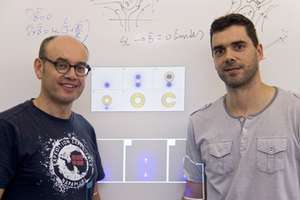Antimagnet: PowerPedia
09.09.2011 Researchers at the Universitat Autònoma de Barcelona (UAB) have obtained a formula for building a " Antimagnet." that can nullify the magnetic field, a discovery that was published in the New Journal of Physics.
UAB researchers publish in New Journal of Physics a formula to
create a device capable of blocking any type of magnetic field. The
antimagnet will make it possible for people with pacemakers to
undergo magnetic resonances and to control the magnetic fields of
technological devices.
Researchers worked to obtain a formula which will cover three objectives. First, an object's magnetic field will not penetrate the exterior once it is covered by the antimagnet. Second, everything cloaked by the antimagnet will be protected from external magnetic fields and the object inside will be undetectable. Third, all materials used to create the antimagnet must be available, i.e. the antimagnet must be manufactured with the use of existing technology.
The formula UAB researchers have devised is based on overlapping layers of materials with different magnetic properties, forming what is known as a metamaterial. The device consists of an internal superconductor layer covered by several layers of ferromagnetic material, separated by air or other materials which do not have magnetic properties.
With this formula, the antimagnet can have different shapes and can block out practically the totality of the magnetic field even if it is not fully closed. Thus the design can be applied to those cases in which the area needing protection by the antimagnet cannot be fully closed off. An example of this would be the blocking of a pacemaker or of a cochlear implant in a patient who needs to undergo a magnetic resonance.
Magnetism is a key element in science and technology; for example, 99 per cent of the energy we consume is generated thanks to the magnetic fields generated by the turbines found in thermal power stations, nuclear and aeolian plants, etc. Scientists are perfectly familiar with the process of creating magnetism. However, the process of 'switching it off' at will is not known. This is a new possibility which appears thanks to the antimagnet.
The fact that the antimagnet can block a specific magnetic field, and that this property depends on temperature - given that one of the components is a superconductor material which must kept at very low temperatures - also paves the way for new devices which can turn a magnetic field "on" and "off" in a specific region. This in turn could give way to new technological applications.
The research, which will be published in New Journal of Physics and was chosen by Physics World as one of the key advances in Physics, was carried out by Àlvar Sánchez, Carles Navau, Jordi Prat and Du-Xing Chen from the UAB Department of Physics; and was funded by the Consolider project Nanoselect.
Reference article: "Antimagnets: Controlling magnetic fields with superconductor-metamaterial hybrids", accepted for publication in New Journal of Physics (2011); arXiv:1107.1647v1
